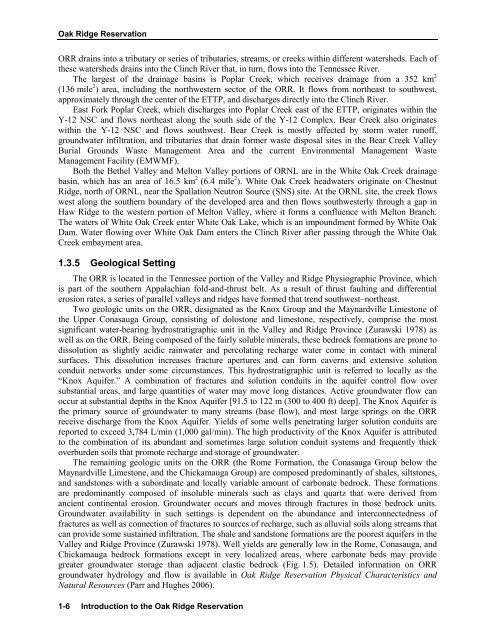DOE/ORO/2327 Oak Ridge Reservation Annual Site Environmental ...
DOE/ORO/2327 Oak Ridge Reservation Annual Site Environmental ...
DOE/ORO/2327 Oak Ridge Reservation Annual Site Environmental ...
You also want an ePaper? Increase the reach of your titles
YUMPU automatically turns print PDFs into web optimized ePapers that Google loves.
<strong>Oak</strong> <strong>Ridge</strong> <strong>Reservation</strong><br />
ORR drains into a tributary or series of tributaries, streams, or creeks within different watersheds. Each of<br />
these watersheds drains into the Clinch River that, in turn, flows into the Tennessee River.<br />
The largest of the drainage basins is Poplar Creek, which receives drainage from a 352 km 2<br />
(136 mile 2 ) area, including the northwestern sector of the ORR. It flows from northeast to southwest,<br />
approximately through the center of the ETTP, and discharges directly into the Clinch River.<br />
East Fork Poplar Creek, which discharges into Poplar Creek east of the ETTP, originates within the<br />
Y-12 NSC and flows northeast along the south side of the Y-12 Complex. Bear Creek also originates<br />
within the Y-12 NSC and flows southwest. Bear Creek is mostly affected by storm water runoff,<br />
groundwater infiltration, and tributaries that drain former waste disposal sites in the Bear Creek Valley<br />
Burial Grounds Waste Management Area and the current <strong>Environmental</strong> Management Waste<br />
Management Facility (EMWMF).<br />
Both the Bethel Valley and Melton Valley portions of ORNL are in the White <strong>Oak</strong> Creek drainage<br />
basin, which has an area of 16.5 km 2 (6.4 mile 2 ). White <strong>Oak</strong> Creek headwaters originate on Chestnut<br />
<strong>Ridge</strong>, north of ORNL, near the Spallation Neutron Source (SNS) site. At the ORNL site, the creek flows<br />
west along the southern boundary of the developed area and then flows southwesterly through a gap in<br />
Haw <strong>Ridge</strong> to the western portion of Melton Valley, where it forms a confluence with Melton Branch.<br />
The waters of White <strong>Oak</strong> Creek enter White <strong>Oak</strong> Lake, which is an impoundment formed by White <strong>Oak</strong><br />
Dam. Water flowing over White <strong>Oak</strong> Dam enters the Clinch River after passing through the White <strong>Oak</strong><br />
Creek embayment area.<br />
1.3.5 Geological Setting<br />
The ORR is located in the Tennessee portion of the Valley and <strong>Ridge</strong> Physiographic Province, which<br />
is part of the southern Appalachian fold-and-thrust belt. As a result of thrust faulting and differential<br />
erosion rates, a series of parallel valleys and ridges have formed that trend southwest–northeast.<br />
Two geologic units on the ORR, designated as the Knox Group and the Maynardville Limestone of<br />
the Upper Conasauga Group, consisting of dolostone and limestone, respectively, comprise the most<br />
significant water-bearing hydrostratigraphic unit in the Valley and <strong>Ridge</strong> Province (Zurawski 1978) as<br />
well as on the ORR. Being composed of the fairly soluble minerals, these bedrock formations are prone to<br />
dissolution as slightly acidic rainwater and percolating recharge water come in contact with mineral<br />
surfaces. This dissolution increases fracture apertures and can form caverns and extensive solution<br />
conduit networks under some circumstances. This hydrostratigraphic unit is referred to locally as the<br />
“Knox Aquifer.” A combination of fractures and solution conduits in the aquifer control flow over<br />
substantial areas, and large quantities of water may move long distances. Active groundwater flow can<br />
occur at substantial depths in the Knox Aquifer [91.5 to 122 m (300 to 400 ft) deep]. The Knox Aquifer is<br />
the primary source of groundwater to many streams (base flow), and most large springs on the ORR<br />
receive discharge from the Knox Aquifer. Yields of some wells penetrating larger solution conduits are<br />
reported to exceed 3,784 L/min (1,000 gal/min). The high productivity of the Knox Aquifer is attributed<br />
to the combination of its abundant and sometimes large solution conduit systems and frequently thick<br />
overburden soils that promote recharge and storage of groundwater.<br />
The remaining geologic units on the ORR (the Rome Formation, the Conasauga Group below the<br />
Maynardville Limestone, and the Chickamauga Group) are composed predominantly of shales, siltstones,<br />
and sandstones with a subordinate and locally variable amount of carbonate bedrock. These formations<br />
are predominantly composed of insoluble minerals such as clays and quartz that were derived from<br />
ancient continental erosion. Groundwater occurs and moves through fractures in those bedrock units.<br />
Groundwater availability in such settings is dependent on the abundance and interconnectedness of<br />
fractures as well as connection of fractures to sources of recharge, such as alluvial soils along streams that<br />
can provide some sustained infiltration. The shale and sandstone formations are the poorest aquifers in the<br />
Valley and <strong>Ridge</strong> Province (Zurawski 1978). Well yields are generally low in the Rome, Conasauga, and<br />
Chickamauga bedrock formations except in very localized areas, where carbonate beds may provide<br />
greater groundwater storage than adjacent clastic bedrock (Fig. 1.5). Detailed information on ORR<br />
groundwater hydrology and flow is available in <strong>Oak</strong> <strong>Ridge</strong> <strong>Reservation</strong> Physical Characteristics and<br />
Natural Resources (Parr and Hughes 2006).<br />
1-6 Introduction to the <strong>Oak</strong> <strong>Ridge</strong> <strong>Reservation</strong>











